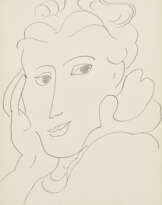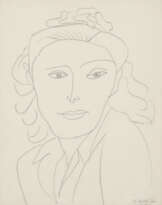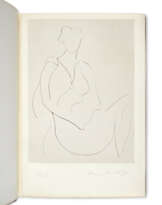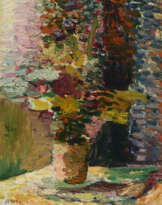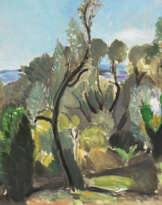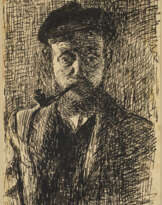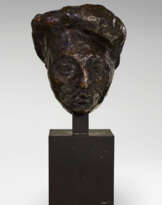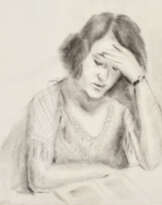ID 929395
Lot 26 | Henri Matisse (1869-1954)
Estimate value
€ 1 200 000 – 1 800 000
Nu couché II
signé des initiales, numéroté et avec le cachet du fondeur ‘H.M 9 CIRE C. VALSUANI PERDUE’ (à l’arrière du bras gauche)
bronze à patine brun foncé
28.2 x 49 cm.
Conçu à Nice en 1927; cette épreuve fondue en 1951 dans une édition de 11 exemplaires
signed with the initials, numbered and stamp with the foundry mark ‘H.M 9. CIRE C. VALSUANI PERDUE’ (at the back of the left arm)
bronze with dark brown patina
11 x 19 1/4 in.
Conceived in Nice in 1927; this bronze cast in 1951 in an edition of 11
Provenance
Atelier de l'artiste.
Pierre Matisse, New York (par descendance).
Puis par descendance au propriétaire actuel.
Literature
C . Duthuit et W. de Guébriant, Henri Matisse, Catalogue raisonné de l’œuvre sculpté, Paris, 1997, p. 196-198, no. 69 (une autre épreuve illustrée, p. 197 et 199).
Special notice
Artist's Resale Right ("droit de Suite").
If the Artist's Resale Right Regulations 2006 apply to this lot, the buyer also agrees to pay us an amount equal to the resale royalty provided for in those Regulations, and we undertake to the buyer to pay such amount to the artist's collection agent.
ƒ: In addition to the regular Buyer’s premium, a commission of 5.5%
inclusive of VAT of the hammer price will be charged to the buyer.
It will be refunded to the Buyer upon proof of export of the lot
outside the European Union within the legal time limit.
(Please refer to section VAT refunds)
Post lot text
Nu couché II est la sculpture finale de la série des trois personnages d’Henri Matisse en position allongée d’odalisque, un thème caractéristique dont il revisite l’expression plastique et formelle et qu’il conçoit sur une période de plus de 20 ans. Cette pose classique, au coude levé, est apparue pour la première fois dans le personnage central de la peinture phare du fauvisme Le Bonheur de vivre, 1905-06 (Fondation Barnes, Philadelphie). L’année suivante, Matisse a sculpté le Nu couché I (Aurore) avec ses angles prononcés, tout en peignant Nu bleu: Souvenir de Biskra (Collection Cone, Baltimore Museum of Art), initiant ainsi un dialogue continu entre ses sculptures et ses peintures qui va dynamiser et guider à plusieurs reprises l’évolution de son travail.
En tant que rêverie de la sensualité féminine, l’odalisque a dominé l’iconographie de Matisse à Nice, depuis 1917 jusqu’à la toute fin de sa carrière. Dix ans après le premier séjour prolongé de l’artiste dans cette ville, le travail en trois dimensions est à nouveau devenu particulièrement important pour le développement de son œuvre. Matisse a repris le travail sur Grand nu assis, commencé en 1922 et il a modelé trois grandes têtes de femmes, Henriette I à III, entre 1925 et 1927. Il est revenu aux personnages allongés dans l'œuvre présentée ici, Nu couché II, 1927 et Nu couché III, 1929. Après avoir enfin terminé Grand nu assis - reconnu comme le chef d’œuvre de l’artiste, toutes techniques confondues, du début de sa période niçoise - Matisse est retourné à Paris et a réalisé Nu de dos, 4e état, la création ultime et la plus synthétique dans sa série de sculptures monumentales, à la fin de 1929 ou au début de 1930.
« J’ai commencé à travailler avec l’argile pour me reposer de la peinture, avec laquelle j’avais fait tout ce que je pouvais à ce moment-là » Matisse expliqua à Pierre Courthion en 1941. « C’était pour mettre de l’ordre dans mes sensations et chercher une méthode qui me convenait vraiment. Quand je l’ai trouvée en sculpture, je l’ai utilisée aussi en peinture » (cité dans S. Guilbert, éd., Chatting with Henri Matisse, The Lost 1941 Interview, Los Angeles, 2013, p. 84-85).
Après avoir rassemblé ses sculptures anciennes, Matisse a navigué à travers le monde pour découvrir la lumière tropicale à Tahiti à la fin de février 1930. Après son retour à Nice, il réalise la fresque Danse pour la Fondation Barnes en 1931. Ce n'est qu'en 1935 que l'artiste a repris la peinture de chevalet de manière régulière, terminant ainsi Grand nu couché (Nu rose), son chef-d’œuvre des années trente. Ayant renoncé au traitement naturaliste qu'il avait l’habitude de choisir pour ses odalisques au cours de la décennie précédente, il a plutôt exprimé dans cette peinture le sens intuitif de la forme, animé par des arabesques, avec des éléments sensuels et structurels maintenus en équilibre, qu'il avait déjà explorés dans Nu couché II.
Nu couché II is the culminating sculpture in Henri Matisse’s series of three figures in the recumbent pose of an odalisque, a signature theme whose formal, plastic expression he revisited and conceived anew over a span of more than twenty years. This classic, raised-elbow pose first appeared in the key figure at the center of the landmark Fauve painting Le Bonheur de vivre, 1905-1906 (The Barnes Foundation, Philadelphia). In the following year, Matisse sculpted the radically angular Nu couché I (Aurore), while painting Nu bleu: Souvenir de Biskra (Cone Collection, Baltimore Museum of Art), initiating an ongoing dialogue between sculpture and painting that would repeatedly energize and guide the evolving direction of his art.
As a reverie of feminine sensuality, the odalisque dominated Matisse’s iconography in Nice, from 1917 to the very end of his career. Ten years after the artist’s initial extended sojourn in the city, working in three dimensions had again become especially critical to his development. Matisse resumed work on Grand nu assis, begun in 1922and modeled three large female heads, Henriette I through III, during 1925-1927. He returned to the reclining figure in the present Nu couché II, 1927 and Nu couché III, 1929. Having finally completed Grand nu assis - acknowledged as the artist’s masterwork, in any medium, of the early Nice period - Matisse returned to Paris and created Nu de dos, 4e état, the ultimate, essentialized conception in his most monumental series of sculptures, during late 1929 or early 1930.
“I took to clay in order to rest from painting, in which I had done absolutely everything I could for the moment,” Matisse explained to Pierre Courthion in 1941. “It was to put my sensations in order and look for a method that really suited me. When I’d found it in sculpture, I used it for painting” (quoted in S. Guilbert, ed., Chatting with Henri Matisse, The Lost 1941 Interview, Los Angeles, 2013, p. 84-85).
Having gathered in his vintage harvest of sculptures, Matisse in late February 1930 sailed halfway around the world to experience the tropical light in Tahiti. Following his return to Nice, he executed in 1931 the Danse murals for The Barnes Foundation. It was not until 1935 that the artist resumed easel painting on a regular basis; he then completed Grand nu couché (Nu rose), his masterpiece of the Thirties. Having dispensed with the naturalistic treatment Matisse typically accorded his odalisques during the previous decade, he instead translated to this painting the intuitive, arabesque-driven sense of form, with sensual and structural elements held in balance, that he had explored earlier in Nu couché II.
| Artist: | Henri Matisse (1869 - 1954) |
|---|---|
| Applied technique: | Metalwork |
| Medium: | Bronze |
| Artist: | Henri Matisse (1869 - 1954) |
|---|---|
| Applied technique: | Metalwork |
| Medium: | Bronze |
| Address of auction |
CHRISTIE'S 9 Avenue Matignon 75008 Paris France | ||||||||||||||
|---|---|---|---|---|---|---|---|---|---|---|---|---|---|---|---|
| Preview |
| ||||||||||||||
| Phone | +33 (0)1 40 76 85 85 | ||||||||||||||
| Fax | +33 (0)1 40 76 85 86 | ||||||||||||||
| Conditions of purchase | Conditions of purchase | ||||||||||||||
| Shipping |
Postal service Courier service pickup by yourself | ||||||||||||||
| Payment methods |
Wire Transfer | ||||||||||||||
| Business hours | Business hours
|












